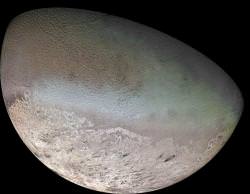With all of the press going to the moons of Jupiter and Saturn, it’s about time that Neptune got a turn. Triton, one of the moons of Neptune, is curious, with large swaths of the planet resembling the skin of a cantaloupe and a retrograde orbit (opposite that of Neptune’s rotation). Its surface is thought to be rather young, and a new method of counting the craters that pock the moon may push the age of Triton’s surface back even younger than previously thought.
Dr. Paul Schenk of the Lunar and Planetary Institute in Houston, and Kevin Zahnle of the NASA Ames Research Center in California revisited the pictures of Triton’s surface that the Voyager 2 spacecraft took in 1989. By clarifying the images with current technology, they were able to count with very high accuracy the amount of craters, and determine the possible causes of the craters. Their results were published in the July 2007 issue of the journal Icarus, in a paper titled On the negligible age of the surface of Triton.
“Our new crater counts benefit from several improvements in the quality of the Voyager images. Although this does not make invisible craters visible, it does increase the ability to discriminate impact features on Triton,” the researchers wrote.
The images showed that the leading hemisphere — the hemisphere of the planet in the direction of its orbit around Neptune — contains many more craters than that of the trailing hemisphere. Triton is tidally locked to Neptune, which means that – like our Moon – an observer on Neptune would always see the same face of Triton. Thus, the same hemisphere would always face the direction of Triton’s orbit around Neptune.
The researchers propose, “Our map of craters on Triton indicates that all definitive impact craters are on the leading hemisphere. The apparent cratering asymmetry of Triton is extreme. The absence of craters on the trailing hemisphere, and the low frequency of craters near the boundary between leading and trailing hemispheres is unique in the Solar System.”
Since Triton is rotating in the opposite direction of everything else that goes around Neptune, it acts like a giant “vacuum cleaner,” and picks up any debris orbiting the planet in a prograde (the same as Neptune’s rotation) direction.
Triton is thought to have given itself a makeover very recently because it was captured by Neptune long ago; most likely, Triton was one body in a binary system, and when Neptune captured it, the other body was thrown out of the Solar System. After being captured, all of the energy that went into slowing Triton down into orbit around Neptune was transferred into heat that melted the surface and interior of the planet. This heat could have lasted for millions of years, and the tidal energy from Neptune may still warm the interior of Triton today.
Normally, areas that have less craters have been resurfaced more recently, and thus are generally younger than surfaces with lots of craters. By analyzing the density of the craters, and using information about the type and frequency of debris that possibly caused them, the researchers were able to calculate that the terrain on the trailing hemisphere with less craters than that of the leading hemisphere was actually older than the area with more craters.
“Whatever their origin, the paucity of impact craters (and heliocentric craters in particular) suggests that Triton’s surface is very young, younger than 100 million years and possibly as young as a few million years. A return to Neptune and its vigorous, dynamic moon Triton is long overdue,” the researchers wrote.
Source: Icarus

